Fig. 7.1
(a, b) A patency file is a small K file inserted 1 mm through the foramen (Courtesy of Fernando Durán-Sindreu)
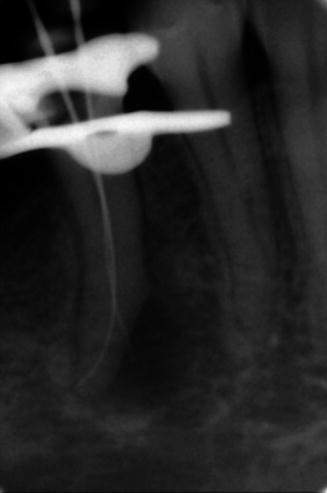
Fig. 7.2
Patency obtained in a two-canal right second lower premolar
The patency file would ideally prevent dentin chips from being compacted into the apical portion of the root canal and from blocking access to this area for instruments and irrigants [1], as well as keeping the foramen open in case drainage is needed from the periapical tissues [24].
The use of a patency file remains controversial, however, because (i) there are no studies showing its efficacy in terms of cleaning and shaping, (ii) periradicular tissues may be irritated, and most importantly (iii) there are no controlled studies showing if using it would improve the prognosis of endodontically treated teeth, either vital teeth or teeth with infected pulp and periapical periodontitis (Fig. 7.3).
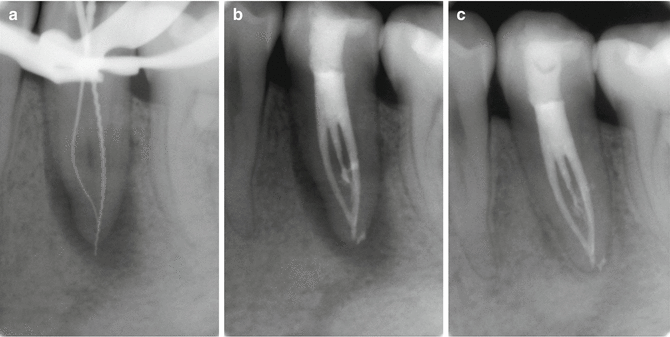

Fig. 7.3
(a, b) Treatment of a left second lower premolar. Patency was maintained throughout the cleaning and shaping procedure. (c) Two-year follow-up
Until now, only one published study has assessed the prevalence of teaching apical patency in US dental schools [8]. The authors conducted a survey in which they got back 48 responses indicating that only 50 % of the schools were teaching the use of the patency file to their students. At the time of the survey, 16 out of 24 programs were teaching the use of patency to their undergraduate students. Nineteen out of 36 schools that had a graduate program were teaching the patency concept.
Concerning the size of the file used in the schools using patency, the size 10 K file was the most popular file used (42 % of respondents), 33 % taught the use of a size 15 K file, and another 25 % recommended the use of a larger size 20 K file. Another question addressed comments against the use of the patency file. Popular responses included concerns regarding the projection of debris into the periapical tissues with concomitant irritation and the lack of proof of an increased success rate. Thus, the purpose of the present literature review is to dissect studies addressing the use and contraindications for the patency file in endodontics.
Role of the Patency File in Shaping, Irrigating, and Cleaning the Root Canal System
On Apical Transportation
Some authors have evaluated the influence of the patency file on the transportation of the apical root canal or the foramen. Goldberg and Massone [13] evaluated ex vivo the apical transportation caused by #10, #15, #20, and #25 K files in 30 human maxillary lateral incisors. Photographic slides of the foramen were taken after the use of every instrument. Transportation was shown in 18 of the 30 specimens. They proved that transportation occurred even after the use of the small 10 K file in five cases in one of the treatment groups (55.5 %). They further stated that because the foramen commonly exits laterally from the apex, it would not be uncommon that the patency file would lean to one of the walls of the apical foramen, modifying its shape in curved canals. Furthermore, Gutierrez et al. proved that a cementum layer could fracture at the apex after penetration of a 15 K file through the main foramen [15].
By contrast, another ex vivo study found that when a size 08 K-Flexofile or a size 10 stainless steel reamer was used, no transportation was found in the majority of the 102 mesiobuccal canals of maxillary and mandibular molars [30]. The authors evaluated root canal transportation at the major foramen by comparing photographs before and after instrumentation. Similar results were obtained by Tsesis et al. [41]. In their study, 10 K patency files were employed after the use of each instrument with the balanced force technique or the Lightspeed system. The study compared transportation to those similar groups in which patency files were not used and then compared superimposed digital images obtained before and after treatment. The authors not only found that using a patency file helped in maintaining working length but also reported no differences in the degree of apical transportation.
On Extrusion of Irrigants and Debris Through the Apical Foramen
Concerning the extrusion of debris through the foramen during cleaning and shaping procedures, differences in the experimental design between published ex vivo studies as well as differences with what would be in vivo clinical situations make it difficult to extrapolate the results of extrusion from ex vivo studies to clinical reality.
Two studies have shown that even without the use of a patency file, extrusion of debris/irrigants occurs frequently in vitro. Lambrianidis et al. [19] used thirty-three human maxillary incisors in their study in which debris and irrigant were measured after being extruded into a glass vial. All root canals were instrumented to the apical constriction with the step-back technique, but a patency file was not used. The total volume of irrigant used per canal was 10 ml. After this procedure, the apical constriction was further enlarged and the measurement was done again. They found more extrusion when the constriction remained intact and concluded that with more instrumentation, the formation of an apical plug could have helped prevent the extrusion of the irrigant, just as it was shown in a previous study assessing extrusion [20].
Another study used a colour-changing reagent in acrylic receptacles in contact with the root tips of maxillary molars [9]. The authors assessed the extrusion of the irrigant without any instrumentation technique used to flare the canals. In phase one of the study, irrigation was done with 3 ml of NaOCl, placing the needle at the entrance of the canal and injecting without pressure after establishing apical patency. In phase two, size 10 and 15 K-Flexofile were used as patency files; then the canals were irrigated again. The study reported extrusion in 9/17 specimens after the use of the 10 K file for patency from phase one and in all specimens from phase two.
These are examples of how variable the results can be when determining this sensitive issue, because the kind of extrusion reported ex vivo would lead to postoperative pain and flare-ups in the vast majority of cases in vivo. By contrast, clinically postoperative pain after root canal therapy occurs with very low incidence. In addition, not blocking the foramen when using ex vivo specimens would not mimic the in vivo situation, allowing for a larger amount of debris and irrigants to be extruded through the foramen. In vivo, the vapour lock effect present in a closed system would result in different intra-canal hydrodynamics [39].
Conclusions
From these results we could conclude that using a small patency file should not alter the anatomy of the apical root canal in a way that could affect clinical results. Further comparative studies with strictly controlled variables should address the influence of a patency file on debris extrusion through the foramen. It is not clear if the use of a patency file would lead to more debris/irrigants being extruded through the apical foramen. Clinically, the use of a patency file helps to maintain working length and to avoid packing debris in the apical third of the complex root canal anatomy.
Role of the Patency File on Irrigant Penetration into the Apical Third of Root Canals
Irrigants should be able to reach the apical third with enough concentration and contact time so that they can dissolve organic tissue, kill planktonic bacteria, and disturb or eliminate biofilms attached to the dentin in the very complex apical anatomy. Salzgeber and Brilliant showed [29] that irrigants (Hypaque) could not reach the apical third of human root canals that contained vital tissue in vivo. They also showed that if the canals were flared to small apical sizes, the irrigant was detected at the apex and, in some instances, in the periapical lesions in nonvital teeth. Instrumentation techniques used at that time would probably push a larger amount of NaOCl and debris through the foramen because of the “pumping” action of hand files. However, comparative studies in vivo have not been carried out to prove such a statement.
In a recent in vivo study using a radiopaque solution Claritrast 300 (ioversol 678 mg/mL) mixed with 5.25 % NaOCl, which was approximated in density and viscosity to that of NaOCl alone, 40 human root canals considered small (buccal roots of maxillary molars, mesial roots of mandibular molars, and both roots of maxillary first premolars) were irrigated with the solution to within 2 ml from the working length (WL) after the use of every rotary instrument. Then, passive ultrasonic irrigation (PUI) was used in both groups for 1 min at the end of the procedure. In group one, apical patency was maintained during the shaping and cleaning procedure with a 10 K file, but not in group two. A blinded calibrated reader determined the presence or absence of the radiopaque irrigating solution in the apical 2 mm of the treated roots. Statistical analysis showed that there was significantly more irrigant after the use of PUI when a patency file had been used throughout the cleaning and shaping procedure compared to the group where it was not [42] (Fig. 7.4).
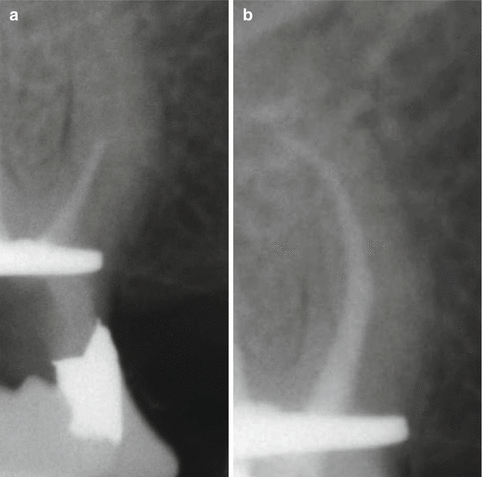

Fig. 7.4
Mixture of a radiopaque solution and NaOCl used as an irrigating solution. (a) Passive irrigation without the use of a patency file delivering the solution at 2 mm from the WL. (b) After the use of a patency file and passive ultrasonic irrigation
In a different study where the same methodology was used [45], penetration of irrigants into the apical 2 mm of 43 large root canals (palatal roots of maxillary molars, distal roots of mandibular molars with one canal, and anterior teeth measuring between 19 and 21 mm) was measured. A 27-G side-vented needle was inserted to 2 ml from the WL with gentle in and out movements and maintaining apical patency, demonstrated a higher incidence of the mixture of NaOCl/radiopaque solution in the apical 2 mm of the root canals compared to those teeth where apical patency was not maintained throughout the cleaning and shaping procedure. It was concluded that the low flow rate used was not very efficient in delivering the irrigant into the apical 2 mm when a patency file was not used.
In both of these studies, the lack of penetration of the irrigant deep into the apical 2 mm could have been caused by the presence of the remaining pulp tissue in the apical anatomy that was not removed adequately by the combination of the cleaning and shaping technique and the dissolving action of NaOCl or the presence of an apical gas bubble or vapour lock effect as proven in some in vitro studies [39]. Furthermore, the gas bubble could grow larger in size because of the reaction of the irrigant with organic tissue [14]. However, other authors have doubted the presence of a vapour lock if a high enough flow is used while irrigating and by also using an open-ended needle that should be positioned closer to the WL [6]. The advantages and risks involved in irrigating in such a way will be discussed in another chapter of this book.
Besides the role of the patency file in the penetration of irrigants into the difficult-to-reach apical anatomy in human root canals, its influence on the presence of large gas bubbles in the middle and cervical third of human root canals in vivo was evaluated in another study [43]. Apical patency was maintained with a 10 K file in two groups (small and big canals), but not in the other two groups also consisting of both small and large canals. Irrigation was also done using a mixture of 5.25 % NaOCl and the radiopaque solution Claritrast 300, which had been tested in pilot studies to dissolve pulp tissue efficiently. Then, a calibrated reader evaluated the presence of gas bubbles in radiographs that were taken during every step of the cleaning and shaping procedure. It was surprising to note that, when present, these gas bubbles could move in the root canal, but they were not easy to break. Furthermore, when a patency file was not used, the gas bubbles in the middle/cervical third appeared in 40 % of the cases, compared to only in 25 % when the 10 K file was used to maintain patency. Even though the importance of such bubbles may not be much concerning the penetration of the irrigants into the apical third, the consistent presence of these bubbles in the middle and cervical thirds would limit the contact of NaOCl with organic tissue and microorganisms attached to the dentin and hiding in isthmuses and areas where there would be more gas than irrigant during the cleaning and shaping procedure. Some other articles have described this vapour lock effect in closed-ended canals/tubes, preventing irrigating solutions from reaching their apex [10]. However, some studies have mentioned the possibility that the change in composition of the irrigant by mixing NaOCl with a radiopaque solution could also vary the density, and especially its viscosity and surface contact angle, when compared to NaOCl by itself, thus favouring the apical vapour lock effect [6].
Conclusions
Using a patency file appears to help irrigants penetrate into the apical 2 mm of the complex anatomy of human root canals both in large and small canals and to prevent gas accumulation in them, at least under the conditions of the aforementioned studies. Whether this in vivo penetration really improves the “cleaning” of the root canal is still not demonstrated and will be discussed further in the following section of this chapter.
The Use and Effect of the Patency File in Cleaning of the Root Canals in Teeth with Vital Pulps
Concerning cleaning and shaping of the apical third, some studies have tested the importance of apical patency during the preparation of the root canal. Some authors have recommended the proper working length to be determined 1–2 mm short of the radiographic apex and avoiding patency [17, 25, 26] (Fig. 7.5).
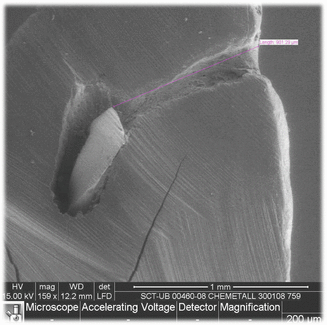

Fig. 7.5
A small K file used short of the foramen. No patency (Courtesy of Fernando Durán-Sindreu)
These authors question and criticize the need for a patency file in cases with vital pulp and actually state that it is contraindicated in cases where there is a clean wound in the apical pulp tissue. A photomicrograph depicting this situation is shown Fig. 7.6, of the buccal root of a maxillary first premolar to be extracted for non-restorability. The pulp was vital and the canals were instrumented before extraction. Rotary NiTi files were employed, 1 % NaOCl was used as the irrigating solution, and the working length was established 1.5 mm short of the radiographic apex. The section shows an apical delta with undisturbed vital tissue. The use of a patency file in such situations could destroy the connective tissue, impairing or delaying wound healing.
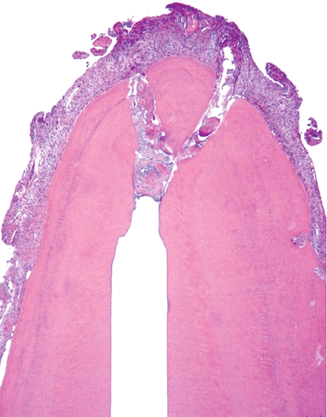

Fig. 7.6
Buccal root of a maxillary first premolar. The pulp was vital and the root canals were instrumented before extraction with NiTi rotary instruments and NaOCl used as the irrigant. WL was established 1.5 mm short of the radiographic apex. Note the apical deltas with undisturbed vital tissue (Courtesy of Domenico Ricucci)
In light of this terminology, it is important to differentiate that the maintenance of apical patency will prevent the blockage of one of the foramens with dentin chips, and not necessarily all of them, because of the complex anatomy of the region (Fig. 7.7). One disadvantage of not using a patency file in noninfected teeth is the possibility of being blocked out or losing working length during instrumentation of the root canal. However, experience and proper use of endodontic instruments should still prevent this accidental procedure. Furthermore, it has been shown clearly that the use of an electronic apex or foramen locator helps determine the ideal position in space for the determination of the optimal working length. The vast majority of studies, as well as indications for the use of different brands of apex locators, recommend advancing the file until the “long” signal is displayed on the screen and then withdrawing it until the display shows “at the foramen” or “slightly short” of the foramen [37
Stay updated, free dental videos. Join our Telegram channel

VIDEdental - Online dental courses


